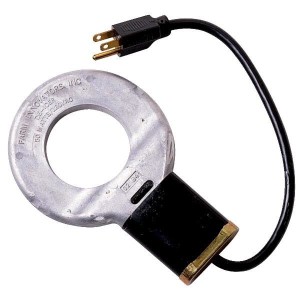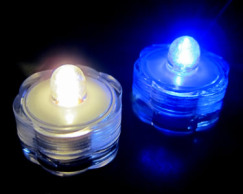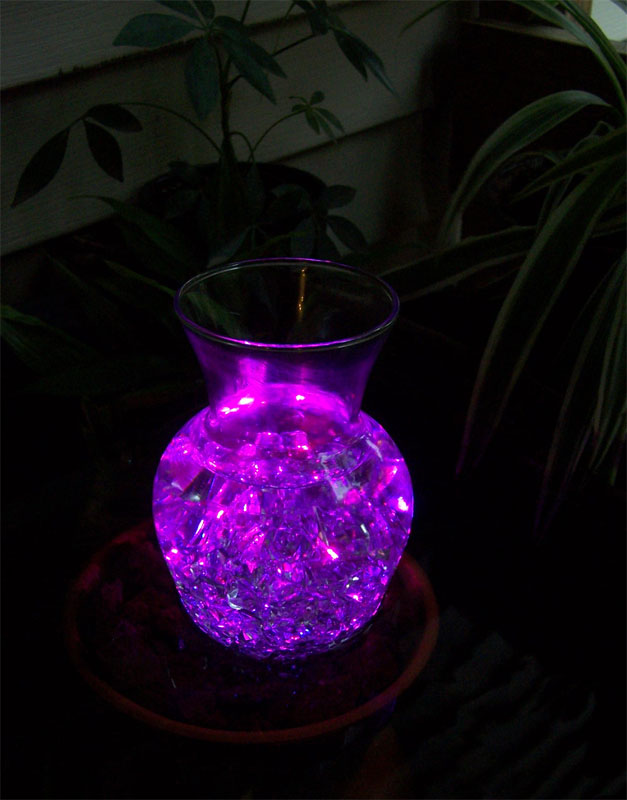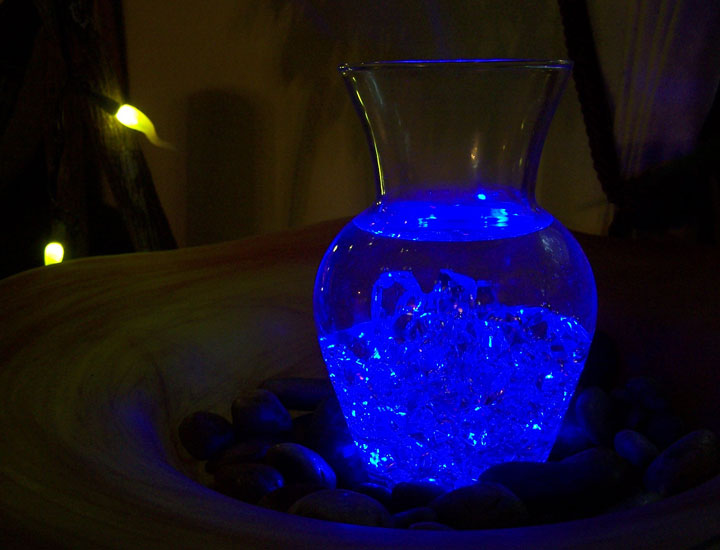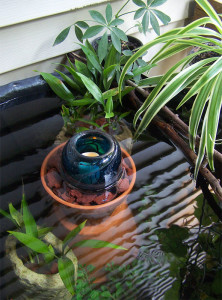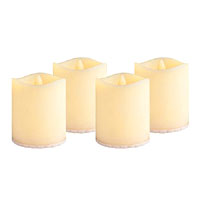Help – My Pond is Full of Algae!
* = products available at Schnarr’s
This is the time of year when small lakes, ponds and water gardens sometimes get green “pea soup” water or mats of algae floating on the surface. The limiting factors for algae growth are mainly food and sunlight. If you can reduce the amount of sunlight and nutrients getting into the water, you can reduce algae growth in your water feature.
First lets look at possible food sources for the algae.
Fertilizer:
Is runoff from your lawn or garden getting into the water? Try reducing the use of artificial fertilizers in those areas. If that is not possible, try creating a rain garden or bioswale in a place that interrupts the water before it reaches the body of water you want to protect. Plants will help take up the extra nutrients before they pollute your water feature.
Plant debris:
Are leaves or other dead plant material decaying in the water? Remove plant debris that falls in ASAP.
Animal waste:
If you have fish in your pond, do you have too many fish for the size of your water feature? Do the fish get too much food? If you overcrowd the water or overfeed your aquatic animals, you will help feed algae as well as cause health problems for the animals. Uneaten food in the water is even worse for water quality than fish waste because it has more nutrients in it. Birds are another source of waste in the water. I have a small water garden specifically intended to attract birds. They bathe in it and sometimes dunk their food in the water to moisten it. Despite that activity, my water garden contains clean-looking, clear water. If you want wild birds to make use of your water feature, that doesn’t automatically mean you have to put up with water that looks like pea soup.
Filtration
Once you have addressed the sources of excess nutrients in the water, I recommend you next take a look at how the water is being filtered. Aquatic plants are great natural filters. Add more marginal and submerged plants to the water, and you will help starve out the algae. Areas around the water that support bog or marsh plants not only help filter water but they give your water feature a more natural appearance.
Artificial filters* are a great help too. I use one in my small water garden and it plays a role in keeping my water garden clean. There are lots of different kinds of filters. Follow the recommendations of the manufacturer of your filter for proper maintenance and cleaning schedules. If you have a type of filter that uses media that you rinse out, rather than replace, rinse the filter media in chlorine free water (such as old pond water that you’ve removed during water changes) so that you don’t kill the beneficial bacteria that live in the filter media. Beneficial bacteria that break down waste grow on just about every surface in the water, but are most numerous where there is porous material and the water flow is swift – conditions that exist inside a filter. These bacteria are what make most filters function. This is called biological filtration. Other types of filtration include chemical and mechanical. Many filter designs, including the sponge filter that I use, combine mechanical and biological filtration. For example the sponge picks up large particles and takes them out of circulation while the bacteria that live in the tiny holes in the sponge digest the water pollutants and turn them into less toxic substances. It’s a good idea to know which kind of filter you have and understand how it works – that will help you understand what to clean and when. For example if I squeeze out my filter’s sponge in a pail of chlorine-free water to remove the debris it’s collected and put the old sponge back in the filter, I’m doing a good thing for the water quality. If I dunked the filter parts in chlorinated water and scrubbed off the thin film that is all over the parts, I would be doing harm to my water quality because I would be removing beneficial bacteria that are helping and not in the way. This is why aquaria and bodies of water that are established and “seasoned” are much easier to keep clean. In the aquarium world, this “seasoning” is called “cycling”. If you are not familiar with cycling, learning more about how it works will help you troubleshoot your water quality.
Don’t forget – the rinse water from cleaning your filter media makes wonderful plant fertilizer!
Reduce sunlight
If you’ve done everything you can to reduce the amount of nutrients in your water, next see if there is a way you can cut down on the amount of sunlight that reaches the water. If you have a small water garden like mine that is portable when empty, you can move it from full sun to part shade and use it for growing part-shade aquatic plants. If you can’t move your water feature, what can you do?
Add shade plants around the edges:
Grow some plants around the edges of the pond that will help cast some shade on the water, if not for a whole day, just part of the day. You could use small trees, bushes, rushes, big annuals with large leaves and many others. Choose plants that can tolerate waterlogged areas or having “wet feet” or add some container plants around the margins.
Grow floating plants:
Water lilies, lotus, water lettuce, water hyacinth, duckweed and many other lovely plants either float right on the surface or emerge at the surface and help provide shade. If you are experimenting with plants that are not native, make sure they don’t get discarded in natural bodies of water. Some floating plants can cause other problems if they cover the entire surface of the water – no more than 50% of the water surface should be covered with plants. Duckweed is an example of a plant that sometimes can blanket the entire surface. This inhibits the exchange of gasses at the water’s surface and can compromise the amount of oxygen in the water. Remove the excess growth and use it as mulch or put it in the compost! That way any overgrowth will be a boon to your garden instead of a nuisance.
More suggestions
Add more oxygen:
Speaking of oxygen, if possible try to increase the amount of oxygen in the water. The addition of a bubbler, fountain or waterfall will help agitate water at the surface and bring in more oxygen. Oxygen is important for the health of the aquatic community as a whole, including the aerobic bacteria that are doing most of the work of keeping the water clean. At Schnarr’s we sell pumps* that can be used to power waterfalls and fountains.
Add minnows:
Small fish like minnows eat some of the algae and as a bonus keep mosquito larvae out of the water as well. Their small size means they produce small amounts of fish waste. Koi or goldfish are wonderful animals with many good qualities but they produce a lot of waste and need a lot of space and clean water to thrive.
UV sterilizers:
A friend of mine struggled with algae in his koi pond until he added a UV sterilizer to his recirculating waterfall. It was effective. He might have been able to avoid the expense by stocking his fish at more reasonable levels but he liked a LOT of fish and was willing to do the extra maintenance required.
Chemical filtration:
You can purchase an algaecide* to kill the algae. This will likely be a short-lived solution because the dead algae will decay and add more dead organic matter to the water which will probably cause either another outbreak of algae later, a drop in oxygen, a toxic ammonia spike or all of those conditions. Addressing the reason the algae is there in the first place is more effective in the long run but it may take some time to notice improvement. An algaecide might work well in a situation where you need a quick fix now but later conditions are not that important. I don’t recommend you use algaecide if you have fish or other aquatic animals that you care about in the water because a sudden deterioration in water quality can cause a die-off. Algaecide makes more sense in something like a small decorative water fountain or other feature that is not intended to support aquatic life.
Safe first aid for an algae-infested pond:
- If practical, perform a 20% water change while vacuuming the bottom with a gravel washer device. This is very easy to do for small water gardens like mine, not possible in a large pond or lake. Use of Clear-Water Pond Clay* 24 hours before you vacuum the gravel will help small particles fall to the bottom where they can be picked up.
- Clean filter medium if you have a filter or add a filter.
- If practical add a bubbler or some device to agitate water surface.
- If you have floating mats of “hair” algae, rake off if possible and use in compost.
- Inoculate the water feature with a live culture of beneficial bacteria – this may not work if you are using a UV sterilizer or if the water is not well aerated. You can buy wet and dry bacteria cultures designed for ponds or request some used gravel from a friend who has an established freshwater aquarium or pond.
- Get some terra cotta plant pots* and scrub well with plain water, no soap or bleach. Do not use if they have ever been used with chemicals that are not pond safe.
- Fill plant pots with rinsed lava rock*.
- Place pots in pond and stack almost to water level to use as a plant stand.
- Set a planter* containing aquatic plants on top of the stack. These could be fully aquatic plants or bog plants as long as the roots can reach the water to take nutrients out of it. Use pots to adjust the water level to what the particular plant needs.
If you don’t want to bother with plants, just add permeable, pond-safe containers of lava rock and if possible place them in a spot where the current is faster. Lava rock is a terrific natural filter medium because it contains many tiny holes for beneficial bacteria to live. Give the bacteria a good home and they will do a lot of your filtration for you.
Additional water garden tips:
The guys who produced this podcast taught me most of what I know about water quality. I think I have listened to every podcast that is archived on their site, and that’s a lot! (The rest I learned from decades of aquarium keeping!) Podcast on Starting a Pond – by the Bailey Brothers
My article on making an indoor water garden:
Create an Indoor Water Garden
Festive lighting tips for your water garden:
Luminous Decor with Flameless Candles: Idea #1
Luminous Decor with Flameless Candles: Idea #2
